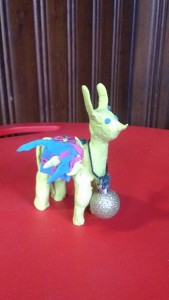Clay model of Al-Buraq
The Buraq (literally lightning) is a creature that transported the Prophet Muhammad during the isra (night journey) and mi’raj (ascension). The angel Gabriel awoke the Prophet in the middle of the night and the Buraq carried Him from his home in Mecca to the farthest mosque, presumably Masjid Al-Aqsa in Jerusalem. After praying there, the Prophet traveled to the different levels of Heaven on the Buraq’s back, where he met various prophets, and finally God himself.
The Buraq is often portrayed as a winged creature with a horse body and a human face. The same is true for this depiction of the Buraq, which was created using modeling clay. Here, the Buraq has long, equine legs, in accordance with a description from Muhammad al-Bukhari, who stated, “The animal’s step reached the farthest point within the reach of the animal’s sight.” The model has large, colorful wings that would enable the Buraq to fly through the heavens. The saddle on his back is covered with floral imagery to represent the lush, verdant heavens through which he carried the Prophet.
In his portrayal, there is a golden light, which hangs around the Buraq’s neck. This light serves multiple symbolic purposes. First, it represents the Prophet Muhammad, who is often depicted as a lamp bringing the light of God into the world. Just as the Buraq carries the light, he carried the Prophet on his journey to Al-Aqsa and the heavens. The light also represents the light of God because the Buraq brought the Prophet to witness God’s greatness in person. The location of the light is not accidental. In some analyses of the isra and the mi’raj, this journey is understood to be an allegory for experiencing the divine, rather than a literal journey. In this case, the Buraq can be interpreted to represent love for God, because in order to truly know God, one needs love. Accordingly, the light is placed on the Buraq’s chest, by its heart, to represent the love for God that allowed the Prophet to experience his majesty.



